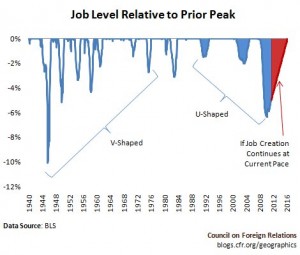08.07.2011
News Releases, Policy Points
CHAPEL HILL (July 8, 2011) – In June, the American economy added only 18,000 more payroll jobs than it lost. Most major industries recorded little net job growth in June, and as a result, the share of the labor force that was underemployed rose to 16.2 percent. These findings come from today’s national employment report.
“The national labor market is deteriorating,” said John Quinterno, a principal with South by North Strategies, Ltd., a research firm specializing in economic and social policy. “Conditions have weakened throughout 2011, though earlier declines were attributed to one-time or seasonal factors. The June employment report exposes how weak the rationalizations have been and lays bare the stark fact that the American jobs machine is not working.”
In June, the nation’s employers added 18,000 more payroll positions than they cut. Gains occurred entirely within the private sector (+57,000), while government payrolls fell by 39,000 positions due mainly to cuts by local and state governments. In recent months, public-sector reductions have weighed down job growth; in June, for instance, government reductions offset 68.4 percent of the total private-sector gain.
Moreover, the payroll employment estimates for April and May were lowered. With the revisions, the economy netted 242,000 jobs over those two months rather than the 286,000 positions previously reported.
Private-sector payroll levels in most every major industry were flat in June. Leisure and hospitality services added the most positions (+34,000), followed by trade, transportation and utilities (+17,000). Financial activities shed the most positions on net (-15,000).
“The June employment report is a terrible one,” noted Quinterno. “Over the past three months, net job growth has averaged just 86,700 positions. This is not what a recovery looks like.”
The inability of the current pace of job growth to change employment conditions was reflected in the June household survey. Last month, 14.1 million Americans (9.2 percent of the labor force) were jobless and seeking work. While the unemployment rate and number of unemployed individuals dropped over the past year, so did the share of the population participating in the labor market. In June, the share of the population participating in the labor force (64.1 percent) remained at a level last seen in the early 1980s.
Another cause for concern is the fact the number of newly unemployed individuals has been trending upward throughout 2011. Last month, 21.7 percent of all unemployed individuals had been jobless for less than 5 weeks. At the other end of the spectrum, the share of workers unemployed for more than six months remained abnormally high. Last month, 44.4 percent of all unemployed workers had been out of work for at least 27 weeks.”
In June, proportionally more adult male workers were unemployed than female ones (9.1 percent vs. 8 percent). Similarly, unemployment rates were higher among Black (16.2 percent) and Hispanic workers (11.6 percent) than among White ones (8.1 percent). The unemployment rate among teenagers was 24.5 percent. Between May and June, unemployment rates for most every major demographic group showed little change.
Additionally, 8.8 percent of all veterans were unemployed in June. The unemployment rate among recent veterans (served after September 2001) was 13.3 percent.
“Jobs remained scarce in June,” added Quinterno. “Last month, the underemployment rate equaled 16.2 percent. Among unemployed workers, the average time out of work was 39.9 weeks.”
“The June employment report shows that the American labor market is not healing itself and that policymakers must take employment issues much more seriously,” observed Quinterno. “Absent focused attention and aggressive action, long-term joblessness is likely to become a permanent scar on American society.”


 Email Sign-Up
Email Sign-Up RSS Feed
RSS Feed